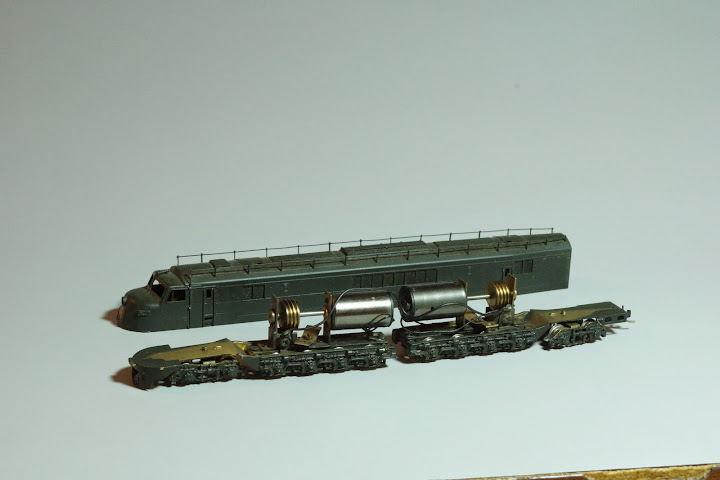Generally speaking, the Kumata brass Centipede is a beautiful piece of crap. The shell overall is wonderful. But usually they run TERRIBLY.

If you are new to this locomotive, what makes it so different is that it has no frame. Yep. No frame--- at all.
The loco is in three sections. Two powered trucks and one shell. The shell is attached to the power assemblies by one bolster.
Getting at the screws is really tough. It is hard to not scratch paint when doing so.

When you pull the shell, you get something like this.

There are some SERIOUS design flaws with this design. Where shall I start.
The entire weight of the loco is held on the V shaped bolster under that drive shaft.
This is the stock configuration. Notice there is a black plastic bushing UNDER the bolster.

This creates a rather high-boy look for this loco.

Here is a truck/power unit.
This is where the insanity resides.

You would think with 4 axles that this thing would pull walls down...... but only 2 axles are powered.
It gets worse.....

This is the key explanatory photo illustrating one truck.

In that photo the red circles are the powered axles. The other two are idlers.
The bolster is at the big yellow X and blue arrow.
By now, you may be thinking.... WHAT?! They placed the balance point of that truck BEHIND the driven axles? That would mean part of the weight is on the idlers.
And you would be correct. Great big brass Centipedes have terrible traction.
Another problem I have come to understand better having worked extensively with brass EP-2s is that DOUBLE motor locomotives does not automatically mean double power. Sometimes is means 50% power.
That is because unless the motors are matched PERFECTLY, they will work against each other and performance will go down (and noise will go up.).
So, my plan is.....
1. Redesign this with a FRAME and gearboxes.
2. Put the weight 100% over the DRIVEN axles.
3. Repower with one really good motor.